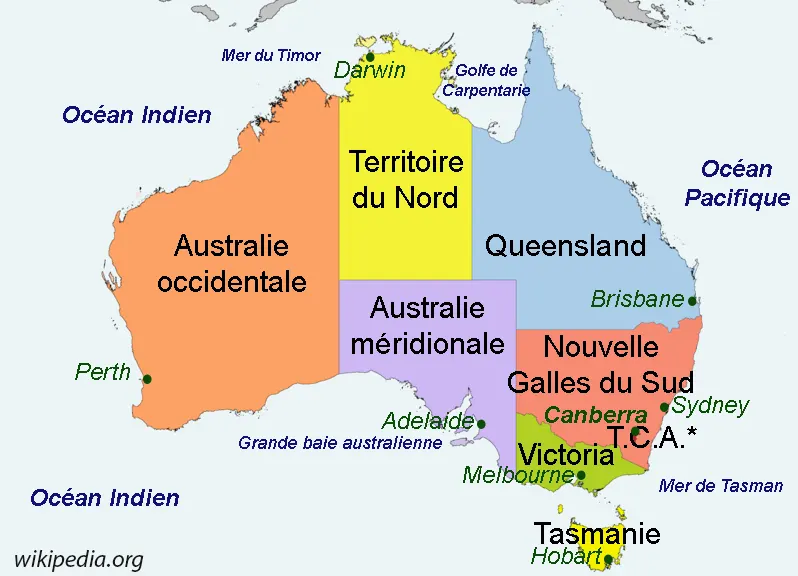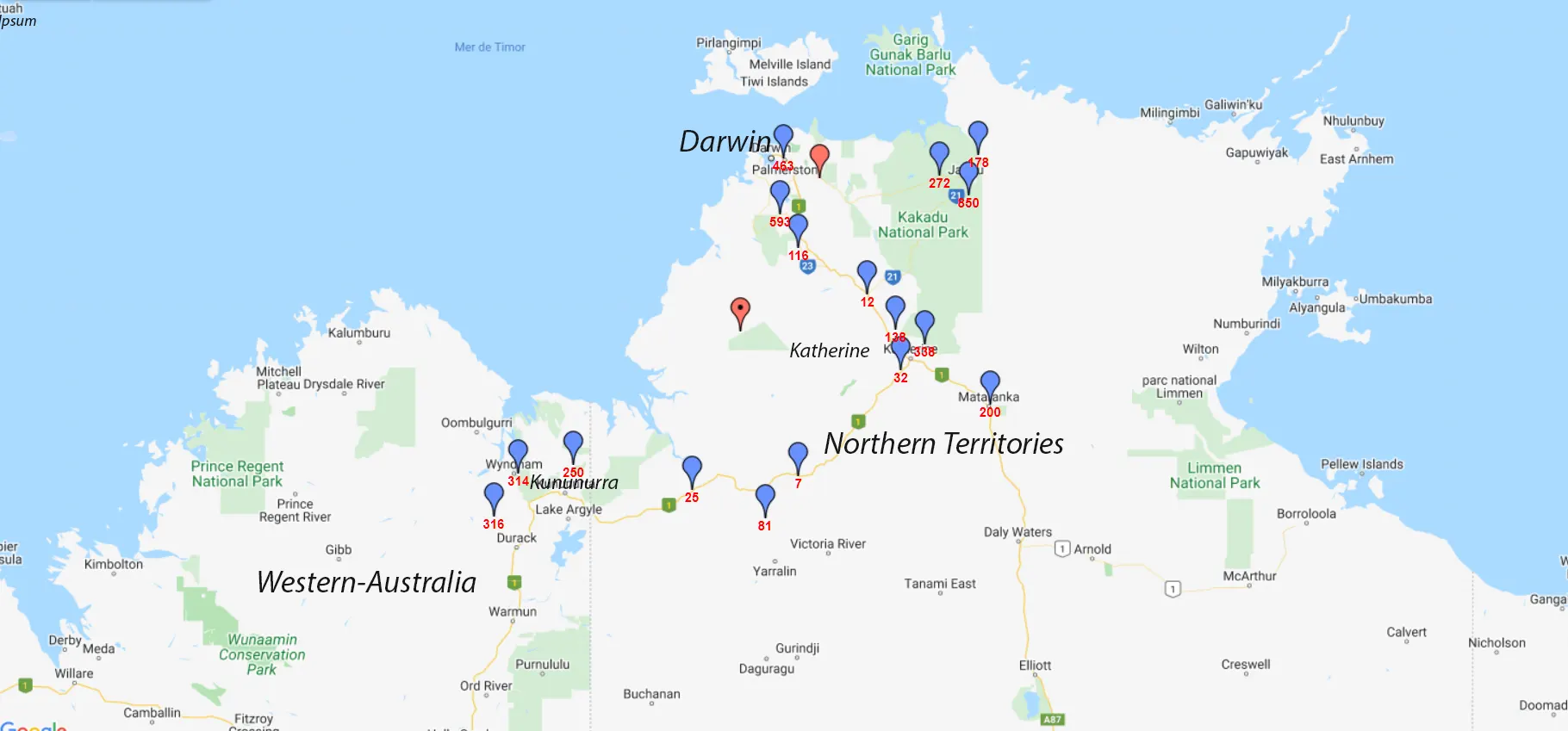These pages concern the Dragonflies of Australia observed in the Northern Territory (the Top End) which I will often abbreviate « NT », and a very small part of Western Australia (WA). But also, since December 2022, the far north of Queensland (FNQ).
The north, the Darwin region and the famous Kakadu National Park is tropical, with a dry season and a wet season; our stay was at the end of the wet season, from April 12 to May 5, 2022.
Further south, it is a savannah region, with rivers, billabongs (pools formed by floods during the wet season) and perennial streams or torrents in rocky areas forming magnificent waterfalls and pools (« rock holes »).
Human presence is sporadic in these vast expanses and the intense heat (34 to 39 °C) is certainly a barrier to occupation of the territory.
Far North Queensland is a humid tropical region, with banana and sugarcane plantations, rainforest, and reliefs that reach 1400 m with numerous small rivers.


Very often, we (Phil, Chris, Denis and I) prospected in the forest, along streams and the light conditions are often difficult requiring the flash.
For the identification of our discoveries, there is a field book, The Complete Field Guide to Dragonflies of Australia by Günther Theischinger and John Hawking, of which I have the 2006 edition; it was updated in 2021, and we all hoped that this edition would correct its shortcomings and be illustrated in a modern and useful way, with field photos or drawings usable for identification; remaining kind, we can say that this guide has the merit of having been reissued…
It was Phil Benstead, who had meticulously prepared this survey, who brought us his knowledge, in particular for the difficult genus Nososticta.
Ian Endersby also published in 2021 a Distribution Atlas which he very kindly sent me: « The Distribution of Australian Dragonflies » which is essential to consult. It should be noted, however, that this work is based on only 60,000 data for 325 species, which, compared to the size of Australia, is extremely low; the Atlas of my department alone, Maine-et-Loire, was based in 2013 on 21,700 data for around sixty species. The surprises were therefore predictable.
The Gomphidae let us down in the Northern Territory ; our stay was probably too late in the season.
The total still reaches 75 species (325 in Australia according to the latest counts), which is not in itself a high score in a tropical region; this region of Australia is not one of the richest, but certainly the least prospected since we had the privilege of meeting and immortalizing 3 species that had never been photographed! For the Queensland
region, the total is not yet established and should reach a hundred species, a better score for the Gomphidae. In total, I photographed 124 species during these two trips. I should also mention the book by Ian Endersby, who, in collaboration with Heinrich Fliedner, tackled the etymology of the names of Australian dragonflies in « The Naming of Australia’s Dragonflies »: it is a very interesting work to which I will refer for each species.
| Lestoideidae | Gomphidae |
| Diphlebia euphoeoides → | Antipodogomphus proselythus → |
| Diphlebia hybridoides → | Austroepigomphus turneri → |
| Lestoidea brevicauda → | Austrogomphus amphiclitus → |
| Lestoidea conjuncta → | Austrogomphus divaricatus → |
| Austrogomphus mjobergi → | |
| Chorismagrionidae | Austrogomphus prasinus → |
| Chorismagrion risi → | Hemigomphus comitatus → |
| Synlestidae | Hemigomphus theischingeri → |
| Synlestes tropicus → | Ictinogomphus australis → |
| Lestidae | Synthemistidae |
| Austrolestes leda → | Eusynthemis nigra → |
| Indolestes alleni → | Choristhemis flavoterminata → |
| Indolestes insularis → | Pseudocordulia circularis → |
| Indolestes tenuissimus → | Tonyosynthemis claviculata → |
| Lestes concinnus → | Corduliidae |
| Argiolestidae | Hemicordulia australiae → |
| Austroargiolestes aureus → | Hemicordulia continentalis → |
| Austroargiolestes icteromelas → | Hemicordulia continentalis → |
| Platycnemididae | Hemicordulia intermedia → |
| Le genre Nososticta en Australie → | Pentathemis membranulata → |
| Nososticta baroalba → | |
| Nososticta coelestina → | Austrocorduliidae |
| Nososticta fraterna → | Austrophya mystica → |
| Nososticta kalumburu → | |
| Nososticta koolpinyah → | Macromiidae |
| Nososticta koongarra → | Macromia tillyardi → |
| Nososticta liveringa → | |
| Nososticta mouldsi → | Libellulidae |
| Nososticta solida → | Aethriamanta circumsignata → |
| Nososticta solitaria → | Aethriamanta nymphaea → |
| Isostictidae | Agrionoptera insignis allogenes → |
| Austrosticta fieldi → | Agrionoptera longitudinalis → |
| Austrosticta soror → | Brachydiplax denticauda → |
| Eurysticta coomalie → | Brachydiplax duivenbodei → |
| Lithosticta macra → | Camacinia othello → |
| Neosticta fraseri → | Crocothemis nigrifrons → |
| Oristicta filicicola → | Diplacodes bipunctata → |
| Rhadinosticta banksi → | Diplacodes haematodes → |
| Coenagrionidae | Diplacodes nebulosa → |
| Aciagrion fragile → | Diplacodes trivialis → |
| Agriocnemis argentea → | Hydrobasileus brevistylus → |
| Agriocnemis dobsoni → | Lathrecista asiatica → |
| Macrodiplax cora → | |
| Agriocnemis pygmaea → | Nannodiplax rubra → |
| Agriocnemis rubricauda → | Nannophlebia eludens → |
| Argiocnemis rubescens → | Nannophlebia injibandi → |
| Austroagrion exclamationis → | Nannophlebia mudginberri → |
| Austroagrion watsoni → | Nannophlebia risi → |
| Austrocnemis maccullochi → | Neurothemis oligoneura → |
| Neurothemis stigmatizans → | |
| Austrocnemis splendida → | Notolibellula bicolor → |
| Ceriagrion aeruginosum → | Orthetrum balteatum → |
| Ischnura aurora → | Orthetrum caledonicum → |
| Ischnura heterosticta → | Orthetrum migratum → |
| Ischnura pruinescens → | Orthetrum villosovittatum → |
| Pseudagrion cingillum → | Orthetrum sabina → |
| Pseudagrion ignifer → | Orthetrum serapia → |
| Pseudagrion jedda → | Pantala flavescens → |
| Pseudagrion lucifer → | Rhodothemis lieftincki → |
| Pseudagrion microcephalum → | Le genre Rhyothemis ► |
| Rhyothemis braganza → | |
| Teinobasis rufithorax → | Rhyothemis graphiptera → |
| Xanthagrion erythroneurum → | Rhyothemis phyllis → |
| Petaluridae | Rhyothemis princeps → |
| Petalura ingentissima → | Rhyothemis resplendens → |
| Telephlebiidae | Tetrathemis irregularis → |
| Austroaeschna speciosa → | Tholymis tillarga → |
| Telephlebia tillyardi → | Tramea loewii → |
| Aeshnidae | Urothemis aliena → |
| Adversaeschna brevistyla → | Zyxomma elgneri → |
| Anax gibbosulus → | Zyxomma petiolatum → |
| Anax guttatus → | |
| Anax papuensis → | |
| Austrogynacantha heterogena → | |
| Dromaeschna forcipata → | |
| Gynacantha dobsoni → | |
| Gynacantha nourlangie → | |